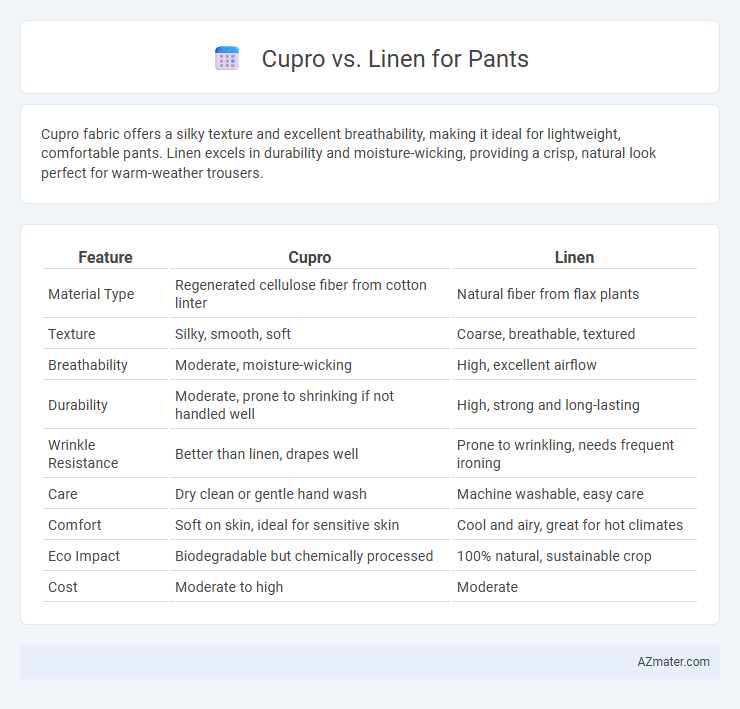Cupro fabric offers a silky texture and excellent breathability, making it ideal for lightweight, comfortable pants. Linen excels in durability and moisture-wicking, providing a crisp, natural look perfect for warm-weather trousers.
Table of Comparison
| Feature | Cupro | Linen |
|---|---|---|
| Material Type | Regenerated cellulose fiber from cotton linter | Natural fiber from flax plants |
| Texture | Silky, smooth, soft | Coarse, breathable, textured |
| Breathability | Moderate, moisture-wicking | High, excellent airflow |
| Durability | Moderate, prone to shrinking if not handled well | High, strong and long-lasting |
| Wrinkle Resistance | Better than linen, drapes well | Prone to wrinkling, needs frequent ironing |
| Care | Dry clean or gentle hand wash | Machine washable, easy care |
| Comfort | Soft on skin, ideal for sensitive skin | Cool and airy, great for hot climates |
| Eco Impact | Biodegradable but chemically processed | 100% natural, sustainable crop |
| Cost | Moderate to high | Moderate |
Introduction to Cupro and Linen Fabrics
Cupro, a regenerated cellulose fiber derived from cotton linter, offers a silky texture, breathability, and excellent moisture absorption, making it an ideal fabric for lightweight, comfortable pants. Linen, obtained from flax fibers, is renowned for its durability, crisp texture, and superior breathability, especially in warm climates due to its natural moisture-wicking properties. Both fabrics provide distinct advantages in pants production, balancing comfort, style, and functionality for seasonal wear.
What is Cupro? Key Characteristics
Cupro is a regenerated cellulose fiber derived from cotton linter, noted for its silk-like smoothness and breathability. It offers excellent moisture-wicking properties, a soft hand feel, and a natural sheen that enhances the drape of pants. Cupro is also biodegradable and hypoallergenic, making it an eco-friendly and comfortable choice compared to traditional linen.
What is Linen? Key Characteristics
Linen is a natural fiber derived from the flax plant, valued for its exceptional breathability and moisture-wicking properties, making it ideal for warm-weather pants. Its lightweight texture and unique slubbed appearance provide a distinctive, casual elegance while offering durability and hypoallergenic benefits. Linen fabrics are known for their tendency to wrinkle easily but soften with wear, enhancing comfort without compromising style.
Cupro vs Linen: Comfort and Breathability
Cupro fabric offers exceptional softness and a silky smooth texture that enhances comfort, making it ideal for sensitive skin compared to linen's slightly coarse feel. Breathability in cupro is moderate due to its semi-synthetic nature but provides good moisture-wicking properties, while linen excels with superior air flow and rapid moisture evaporation, keeping the wearer cooler in hot weather. Both materials are breathable, yet linen outperforms in heat management, whereas cupro delivers a blend of comfort and moisture control suitable for warmer climates.
Durability and Longevity Comparison
Cupro fabric, made from regenerated cellulose fibers, offers moderate durability with a smooth texture but tends to be less resistant to abrasion over time compared to linen. Linen, derived from flax fibers, is highly durable, known for its strength and ability to withstand frequent wear and washing while maintaining structural integrity. For long-lasting pants, linen outperforms cupro in terms of longevity due to its natural fiber resilience and superior tensile strength.
Environmental Impact: Sustainability Factors
Cupro, derived from regenerated cellulose fibers, is biodegradable and often produced using recycled cotton waste, reducing fabric waste and lowering environmental toll compared to conventional fabrics. Linen, made from flax plants, requires minimal water and pesticides, making it one of the most eco-friendly natural fibers with a lower carbon footprint and excellent biodegradability. While both fibers offer sustainable benefits, cupro's closed-loop production system contrasts with linen's naturally low-input agricultural process, highlighting different approaches to eco-conscious pant materials.
Style and Appearance Differences
Cupro pants offer a smooth, silky finish that drapes elegantly, providing a polished and refined appearance suitable for formal or sophisticated styles. Linen pants exhibit a natural, textured weave with a matte finish, creating a casual, breathable look ideal for warm weather and relaxed, effortless outfits. The subtle sheen of cupro contrasts with linen's rustic texture, making each fabric distinct in visual appeal and style versatility.
Maintenance and Care Tips
Cupro pants require gentle washing with mild detergent and should be air-dried to prevent shrinking and maintain fabric softness. Linen pants need hand washing or machine washing on a delicate cycle, followed by immediate ironing while damp to reduce wrinkles and preserve fabric strength. Both fabrics benefit from avoiding bleach and high heat to extend their lifespan and maintain optimal appearance.
Ideal Uses for Cupro vs Linen Pants
Cupro pants excel in formal and office settings thanks to their smooth texture, moisture-wicking properties, and drapability, making them ideal for professional attire and evening wear. Linen pants are perfect for casual, warm-weather occasions because of their breathability, lightweight nature, and natural wrinkle-prone appearance, which enhances a relaxed, laid-back style. Choosing Cupro suits environments requiring elegance and comfort, while Linen is preferred for outdoor, summer, and beachwear due to superior ventilation and cooling.
Conclusion: Choosing the Right Fabric for Your Needs
Cupro offers a silky texture, breathability, and durability ideal for polished, comfortable pants suitable in both casual and formal settings. Linen provides a lightweight, highly breathable option with a natural, textured appearance perfect for warm climates and relaxed styles. Selecting between cupro and linen pants depends on your preference for fabric feel, climate considerations, and the intended occasion for wear.

Infographic: Cupro vs Linen for Pants
 azmater.com
azmater.com